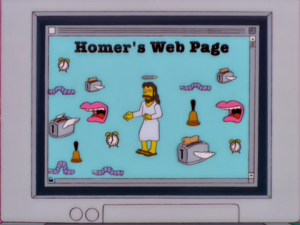Video for source credibility
Image courtesy Simpsons Wiki
The Simpsons: Season 12, episode 6
Early in this episode of The Simpsons is a brief scene that is a wonderful illustration of the problem of trusting unknown Internet sources. Homer wants to create a web page, but is having trouble coming up with material. He decides to rely on an unfounded rumor that the Bart has heard. (This scene happens shortly after the tire crashes through the window.)
The rest of the episode has other illustrations of problems that can be caused by relying on Internet sources.
The episode is available for free with a cable or DirecTV account number at SimpsonsWorld.com.
Web resource for public speaking advice
Entrepreneur magazine online offers “10 Honest and Completely Helpful Tips for Hitting a Public-Speaking Homerun.” The article is written in a light and funny style, yet hits most of the important points that public speaking teachers try to drive home — tell stories, do not read, and do not try to be someone else during your speech. There is also very good advice for handling Q&As.
The article also provides links to related points like the PowerPoint 10, 20, 30 rule. It would be a nice reading assignment to include about style if you are not using a public speaking textbook (say, including public speaking as part of another class) or to offer to students who have everything else working but still struggle with nerves or an overly formal presentation style.
Google can brin…
Google can bring you back 100,000 answers. A librarian can bring you back the right one.
– Neil Gaiman
Advice for high school students
Teacher Ryan Gaskill summarizes the advice that he gives to high school students about their in-class presentations in this blog post. It is written directly to high-school students.
This five-point list would be good to share with students before their presentations either in class or online. It would be helpful not only for speech teachers, but also classes where students may give only a single oral presentation.
In-class exercise for research and evaluating sources
Public speaking textbook author Joe DeVito suggested this in-class activity for maximizing research time and evaluating sources: http://tcbdevito.blogspot.com/2013/02/research-efficiency-and-reliability.html#more
Find more entries on his blog here: http://tcbdevito.blogspot.com/
Give me a stat…
Give me a stat, and I don’t give a damn. Tell me a story, and I weep like a baby.
Chris Marlow, Director of Help One Now
The importance of citing sources
The importance of citing sources
One persistent challenge I faced while teaching public speaking was convincing students of the need to cite their sources and how to do it properly. My syllabus contained strong point deductions for giving a speech with no sources and the deductions increased with each speech. This gave them at least one compelling reason to remember to use sources. Other than that, I mentioned the importance of sources early and often — starting with the second day of class and a discussion of ethos. Many textbooks put the discussion of ethos toward the end, but it is more effective to cover early in class to provide the “whys” of much of the advice to come in the first unit.
During the persuasive speaking unit, I used a running example of a speech about legalizing drugs and how it would be put together. I created and presented this example of an effective source citation.

In-class activity for ethics, ethos, or research
This is a simple activity but I’ve found it to be very helpful with students who are less prepared to do research and unsure about giving source citations.
Bring in a bunch of newspaper pages. I would separate a Sunday newspaper into pages. Have them work alone or with a partner and scan the articles to find a first-reference source citation. Go over HOW the source is cited. What information is given about the source besides their name? Do you get a sense of their credibility? How? Did it take very long to do so? This is how sources should be cited in a speech as well…
It is harder to conceal i…
It is harder to conceal ignorance than to acquire knowledge.
John Dewey, philosopher

